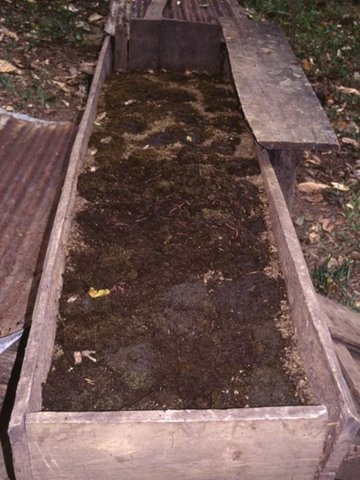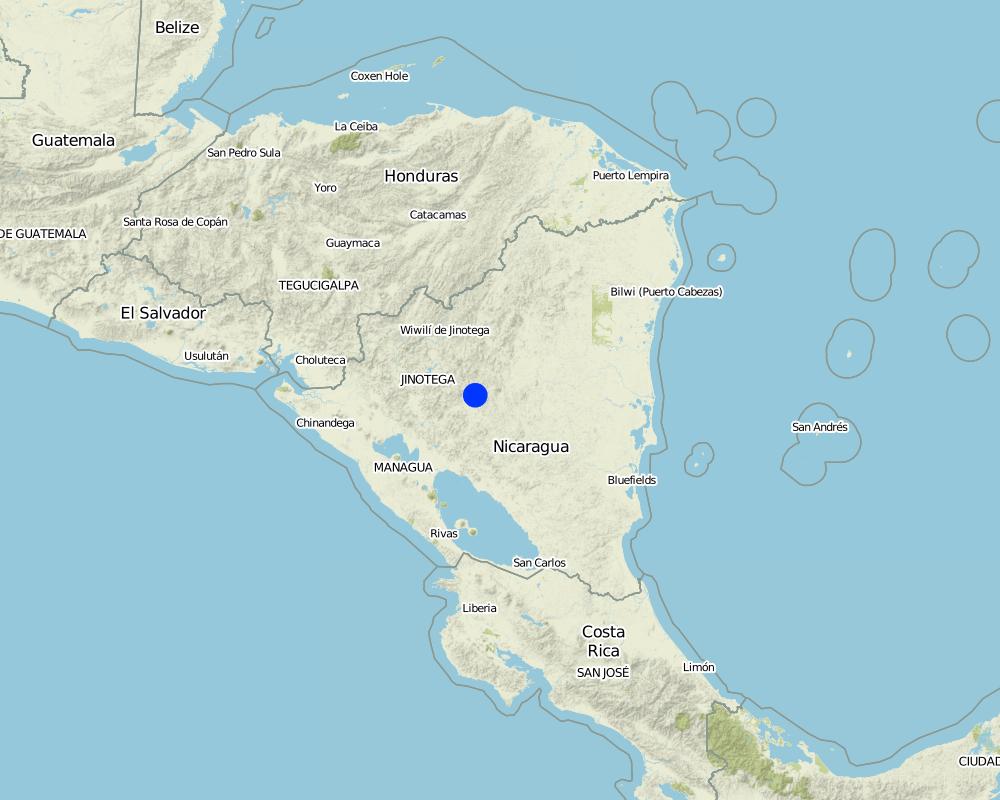Productive development and food security programme [นิการากัว]
- ผู้สร้างสรรค์:
- การอัพเดท:
- ผู้รวบรวม: Philippe Zahner
- ผู้เรียบเรียง: –
- ผู้ตรวจสอบ: David Streiff, Deborah Niggli
approaches_2349 - นิการากัว
ดูส่วนย่อย
ขยายทั้งหมด ย่อทั้งหมด1. ข้อมูลทั่วไป
1.2 รายละเอียดที่ติดต่อได้ของผู้รวบรวมและองค์กรที่เกี่ยวข้องในการประเมินและการจัดเตรียมทำเอกสารของแนวทาง
ผู้เชี่ยวชาญ SLM:
Gómez Julio
(505) 0772-7108
addacentral@addac.org
ADDAC Managua, Nicaragua
De ENITEL 3c al Norte y 75 varas al Este. Calle Santa Ana, Apartado Postal 161, Matagalpa, Nicaragua
ชื่อของโครงการซึ่งอำนวยความสะดวกในการทำเอกสารหรือการประเมินแนวทาง (ถ้าเกี่ยวข้อง)
Book project: where the land is greener - Case Studies and Analysis of Soil and Water Conservation Initiatives Worldwide (where the land is greener)ชื่อของโครงการซึ่งอำนวยความสะดวกในการทำเอกสารหรือการประเมินแนวทาง (ถ้าเกี่ยวข้อง)
Asociación para la Diversificación y el Desarrollo Agricultural Comunal (ADDAC) - นิการากัว1.3 เงื่อนไขที่เกี่ยวข้องกับการใช้ข้อมูลที่ได้บันทึกไว้ผ่านทาง WOCAT
ผู้รวบรวมและวิทยากรหลักยอมรับเงื่อนไขเกี่ยวกับการใช้ข้อมูลที่ถูกบันทึกผ่านทาง WOCAT:
ใช่
1.4 การอ้างอิงถึงแบบสอบถามเรื่องเทคโนโลยี SLM

Vermiculture [นิการากัว]
Continuous breeding of earthworms in boxes for production of high quality organic compost.
- ผู้รวบรวม: Ramén Ernesto Caceres Ordonez
2. คำอธิบายของแนวทาง SLM
2.1 การอธิบายแบบสั้น ๆ ของแนวทาง
An integrated programme-based approach promoting participatory testing and extension of various SWC technologies, as well as providing institutional support.
2.2 การอธิบายอย่างละเอียดของแนวทาง
การอธิบายอย่างละเอียดของแนวทาง:
Aims / objectives: The Association for Agricultural Community Development and Diversification (ADDAC) is a non-profit NGO, founded in 1989, whose mission is to improve the living standard of poor rural families engaged in small/medium scale farming in marginal areas to the north of Nicaragua. The main purpose of ADDAC's approach is to develop and strengthen local capacity to analyse problems and find solutions for rural sustainable development. There are five main components: (1) food security and productive development, including technological improvement and diversification within traditional crop cultivation, and extension of alternative agricultural land use practices; (2) support to farmers??? organisations; (3) promotion of gender equality; (4) identification of alternatives in marketing; and (5) provision of an alternative credit system for farming. These fields of activities are based on the principles of organic agriculture and a powerful training process - using the methodology of 'popular education', which involves participatory training and extension activities.
Methods: ADDAC initiates its work in communities through PRA (Participatory Rural Appraisal) - evaluating problems and potential solutions. These serve as a base for the formulation of project proposals which are then submitted to interested financing organisations. Further steps include participatory planning, and later, evaluation, in collaboration with the land users. For execution of activities ADDAC contracts an interdisciplinary crew of specialists, which stays in the area. Twice a year a participatory reunion is organised to evaluate, and accordingly improve, the activities. Key to the approach is the formation of a grassroots organisation in each community to guarantee local management, build up alternative enterprises and promote community development. These organisations consist of representatives of local support groups, and farmers with a leading role in SWC application and extension. The organisations have various functions during the lifetime of a project: they are the counterparts of the extensionists for project execution, and later they ensure sustainability of activities. Farmers' associations are formed to improve storage and marketing of crops. Networks of local promoters exchange experience between communities and consolidate extension of alternative technologies. Demonstration farms serve as a tool for technology extension, innovation and validation.
2.5 ประเทศ ภูมิภาค หรือสถานที่ตั้งที่ได้นำแนวทางไปใช้
ประเทศ:
นิการากัว
ภูมิภาค/รัฐ/จังหวัด: :
Matagalpa
Map
×2.6 วันที่เริ่มต้นและสิ้นสุดของแนวทาง
ระบุปีที่เริ่ม:
1989
2.7 ประเภทของแนวทาง
- ใช้โครงงานหรือแผนงานเป็นฐาน
2.8 เป้าหมายหรือวัตถุประสงค์หลักของแนวทาง
Support the economical sustainability and food security of land users in the project area through increased production, diversification, soil conservation and environmental protection. - develop feasible production models, aimed at self-sufficiency and the integration of land users into an alternative internal and external market; build up alternative forms of marketing and credit systems. - community development and capacity building: build-up local farmers' organisation
The SLM Approach addressed the following problems: Lack of organisation and skills to analyse and overcome underlying problems of: - poverty; lack of financial resources for investments (eg in SWC). - insufficient food/poor nutrition. - soil degradation/indiscriminate burning of vegetation. - lack of appropriate technologies. - lack of access to public services and markets
2.9 เงื่อนไขที่เอื้ออำนวยหรือเป็นอุปสรรคต่อการนำเทคโนโลยีภายใต้แนวทางนี้ไปปฏิบัติใช้
บรรทัดฐานและค่านิยมทางสังคม วัฒนธรรม ศาสนา
- เป็นอุปสรรค
Resistance to implement SWC technologies by some land users
Treatment through the SLM Approach: Awareness raising, demonstration plots, convince with facts.
การมีไว้ให้หรือการเข้าถึงแหล่งการเงินและบริการ
- เป็นอุปสรรค
Poverty, lack of resources for investments into SWC.
Treatment through the SLM Approach: Support in the form of credit, basically in kind but also in cash (see credit section).
การจัดตั้งระดับองค์กร
- เป็นอุปสรรค
Lack of collaboration between land users.
Treatment through the SLM Approach: Strengthen farmers' organisation.
กรอบแนวทางในการดำเนินการด้านกฎหมาย (การถือครองที่ดิน สิทธิในการใช้ที่ดินและน้ำ)
- เอื้ออำนวย
Most of the land users have individual properties which facilitates the implementation of the SWC approach activities.
- เป็นอุปสรรค
Lack of land use rights.
Treatment through the SLM Approach: Problem cannot be resolved under the project.
3. การมีส่วนร่วมและบทบาทของผู้มีส่วนได้ส่วนเสียที่เกี่ยวข้อง
3.1 ผู้มีส่วนได้ส่วนเสียที่เกี่ยวข้องในแนวทางนี้และบทบาท
- ผู้ใช้ที่ดินระดับท้องถิ่นหรือชุมชนระดับท้องถิ่น
The integration of women is a key element of the approach. Nevertheless, there are moderate differences due to cultural factors: men are mainly in charge of agricultural activities, whereas women work in the household.
- ผู้เชี่ยวชาญ SLM หรือที่ปรึกษาการเกษตร
- รัฐบาลแห่งชาติ (ผู้วางแผน ผู้ทำการตัดสินใจ)
3.2 การเกี่ยวข้องของผู้ใช้ที่ดินระดับท้องถิ่นหรือชุมชนระดับท้องถิ่นในช่วงต่างๆของแนวทาง
| ความเกี่ยวข้องของผู้ใช้ที่ดินระดับท้องถิ่นหรือชุมชนระดับท้องถิ่น | ระบุผู้ที่มีส่วนเกี่ยวข้องและอธิบายกิจกรรม | |
|---|---|---|
| การริเริ่มหรือการจูงใจ | ปฏิสัมพันธ์ | rapid/participatory rural appraisal; participatory planning in public meetings |
| การวางแผน | ปฏิสัมพันธ์ | public meetings, workshops/seminars; assemblies for municipal planning (elaboration of community action plan) |
| การดำเนินการ | ปฏิสัมพันธ์ | responsibility for major steps; execution of the action plans where each community decides |
| การติดตามตรวจสอบหรือการประเมินผล | ปฏิสัมพันธ์ | Mainly: public meetings; partly: workshop/seminars, measurements/observations; a specialist is in charge of the continuation of activities and of the planning process with each community; annual assembly of delegates representing all communities assisted by ADDAC |
| Research | ปฏิสัมพันธ์ | on-farm; on-farm experimentation with interested land users: assessment of different technologies (variety tests, evaluation of ecological effects, etc) |
3.4 การตัดสินใจเลือกใช้เทคโนโลยี SLM
ระบุผู้ที่ทำการตัดสินใจเลือกเทคโนโลยีมากกว่าหนึ่งวิธีไปปฏิบัติใช้:
- ผู้ใช้ที่ดินเป็นผู้ตัดสินใจหลัก โดยการสนับสนุนจากผู้เชี่ยวชาญ SLM
การอธิบาย:
Decisions on the method of implementing the SLM Technology were made by mainly by land users supported by SLM specialists
4. การสนับสนุนด้านเทคนิค การสร้างขีดความสามารถ และการจัดการด้านความรู้
4.1 การสร้างขีดความสามารถ / การอบรม
ได้มีการจัดอบรมให้แก่ผู้ใช้ที่ดินหรือผู้มีส่วนได้ส่วนเสียคนอื่น ๆ หรือไม่:
ใช่
รูปแบบการอบรม:
- เกษตรกรกับเกษตรกร
- ใช้พื้นที่ทำการสาธิต
- จัดการประชุมสู่สาธารณชน
หัวข้อที่พูด:
The form of training promoted by ADDAC is called 'popular education'. It is a continuous and participatory process of mutual learning between farmers and technicians, based on a course of 'action - reassessment - action', with the aim of re-establishing indigenous knowledge, improving local self-esteem and the ability to analyse innovations, and, in the long term, to build up the capacity withi
4.2 การบริการให้คำแนะนำ
ผู้ใช้ที่ดินมีการเข้าถึงการรับบริการให้คำปรึกษาหรือไม่:
ใช่
ระบุว่ามีบริการให้คำปรึกษาหรือไม่:
- ไปเยี่ยมชมสถานที่
การอธิบาย/แสดงความคิดเห็น:
Key elements: demonstration areas, technical assistance through farm visits, farmer-to-farmer extension, local promoters organised into 'Local Support Groups', associated network.
4.3 การเสริมความแข็งแกร่งให้กับสถาบัน (การพัฒนาองค์กร)
สถาบันได้รับการจัดตั้งขึ้นมาหรือเสริมความแข็งแกร่งโดยแนวทางนี้หรือไม่:
- ใช่ เล็กน้อย
ระบุระดับของสถาบันที่ได้รับการเสริมความแข็งแกร่งหรือจัดตั้งขึ้นมา:
- ท้องถิ่น
- building up groups (see Annexe 3)
4.4 การติดตามตรวจสอบและประเมินผล
การติดตามตรวจสอบและประเมินผลเป็นส่วนหนึ่งของแนวทางหรือไม่:
ใช่
ความคิดเห็น:
Socio-cultural aspects were ad hoc monitored by 0 through observations; indicators: land users needs
Economic / production aspects were ad hoc monitored by 0 through observations; indicators: nutritional security, cost-benefit-ratio, deversification, organic products, certified production, production for markets
No. of land users involved aspects were regular monitored by 0 through measurements; indicators: strategic plan, progress of project
Management of Approach aspects were regular monitored by None through measurements; indicators: None
Training aspects were regular monitored by None through observations; indicators: land users trained as local promoters
There were several changes in the Approach as a result of monitoring and evaluation: at the beginning the approach consisted only of two components: training and research. Then it was broadened to involve extension of SWC technologies and promotion of crop diversification. Later the credit programme and the organisational component became part of the approach. The approach activities are supposed to be a continuously expanded based on the needs of the land users.
4.5 การวิจัย
การวิจัยเป็นส่วนหนึ่งของแนวทางหรือไม่:
ใช่
ระบุหัวข้อเรื่อง:
- เทคโนโลยี
ให้ข้อมูลเพิ่มเติมและให้ระบุผู้ทำการวิจัย:
Research is carried out on demonstration farms through local promoters. Topics include on-farm testing of technologies, and adaptive trials with maize and pea varieties.
5. การสนับสนุนด้านการเงินและวัสดุอุปกรณ์
5.1 ระบุงบประมาณประจำปีสำหรับแนวทาง SLM นี้
แสดงความคิดเห็น (แหล่งของการระดมทุน ผู้บริจาคคนสำคัญ):
Approach costs were met by the following donors: international non-government (-): 90.0%; national non-government (-): 10.0%
5.2 การสนับสนุนด้านการเงิน / วัสดุอุปกรณ์ให้แก่ผู้ใช้ที่ดิน
ผู้ใช้ที่ดินได้รับการสนับสนุนด้านการเงิน / วัสดุอุปกรณ์ไปปฏิบัติใช้เทคโนโลยีหรือไม่:
ไม่ใช่
5.3 เงินสนับสนุนสำหรับปัจจัยนำเข้า (รวมถึงแรงงาน)
- อุปกรณ์
| ระบุปัจจัยนำเข้าที่ได้รับการสนับสนุน | เห็นด้วยระดับไหน | ระบุเงินสนับสนุน |
|---|---|---|
| เครื่องมือ | ได้รับการช่วยเหลือทางการเงินบางส่วน | |
- การเกษตร
| ระบุปัจจัยนำเข้าที่ได้รับการสนับสนุน | เห็นด้วยระดับไหน | ระบุเงินสนับสนุน |
|---|---|---|
| fresh cattle manure | Gift from neigbours to farmers who don't have cattle | |
- โครงสร้างพื้นฐาน
| ระบุปัจจัยนำเข้าที่ได้รับการสนับสนุน | เห็นด้วยระดับไหน | ระบุเงินสนับสนุน |
|---|---|---|
| community infrastructure | ได้รับการช่วยเหลือทางการเงินแบบเต็ม | |
ถ้าแรงงานโดยผู้ใช้ที่ดินเป็นปัจจัยนำเข้าที่มีอยู่มากมาย ระบุด้วยว่าเนื่องจาก:
- สมัครใจ
ความคิดเห็น:
land users works on their own farms at their own cost.
5.4 เครดิต
มีการจัดหาเครดิตมาให้ภายใต้แนวทาง SLM หรือไม่:
ใช่
ถ้าใช่ ระบุเงื่อนไข (อัตราดอกเบี้ย การชำระคืน):
Interest rate charged: 1.5%; repayment conditions: Credit was provided through the programme of alternative financing by ADDAC. The 1.5% interest rate (lower than the market rate) is accessible to individuals and organised groups..
Interest was lower than market rate.
6. การวิเคราะห์ผลกระทบและการสรุป
6.1 ผลกระทบของแนวทาง
ช่วยให้ผู้ใช้ที่ดินนำเอาเทคโนโลยี SLMไปใช้และบำรุงรักษาสภาพไว้ได้หรือไม่:
- ไม่ใช่
- ใช่ เล็กน้อย
- ใช่ ปานกลาง
- ใช่ อย่างมาก
Did other land users / projects adopt the Approach?
- ไม่ใช่
- ใช่ เล็กน้อย
- ใช่ ปานกลาง
- ใช่ อย่างมาก
There are 6 more projects assisted by ADDAC, which use the same approach in the north of Nicaragua.
6.3 ความยั่งยืนของกิจกรรมของแนวทาง
ผู้ใช้ที่ดินสามารถทำให้สิ่งต่างๆ ที่ได้ปฏิบัติใช้โดยแนวทางนี้ยั่งยืนได้หรือไม่ (โดยไม่มีการสนับสนุนจากภายนอก):
- ใช่
6.4 จุดแข็งและข้อได้เปรียบของแนวทาง
| จุดแข็ง / ข้อได้เปรียบของแนวทางในทัศนคติของผู้รวบรวมหรือวิทยากรหลัก |
|---|
| Growing active integration of women (25% more contribution to farm income and >25% more participation in decision making in comparison with non-participants) (How to sustain/ enhance this strength: Keep the gender programme as a component of the approach.) |
| Farmers' organisations: build up capacity for autonomous management of alternative development activities (How to sustain/ enhance this strength: Integrate more farmers in the baseline organisations.) |
| Efficient extension method: 86% of involved land users apply more than 3 different SWC technologies promoted by the approach which contributes to sustainable development of the region (How to sustain/ enhance this strength: Maintain and extend present farmer-to-farmer extension system: continue training of local promoters, network of promoters, local support group.) |
| Evaluation of land users' needs and involvement of new approach components according to their needs; continuous mutual learning process between land users and between land users and extensionists/specialists (How to sustain/ enhance this strength: Continue the present 6-monthly evaluation procedures; implement a system of information, communication, evaluation and monitoring to analyse the impact of the approach activities.) |
| Increasing self-esteem of the people. |
6.5 จุดอ่อน / ข้อเสียเปรียบของแนวทางและวิธีในการแก้ไข
| จุดอ่อน / ข้อเสียเปรียบในทัศนคติของผู้รวบรวมหรือวิทยากรหลัก | สามารถแก้ไขปัญหาได้อย่างไร |
|---|---|
| Process takes long and requires high inputs of human resources and materials | In an integrated approach with strong participation of land users this problem is unavoidable; formulation of good project proposals help in finding donors to finance long-term programmes. |
7. การอ้างอิงและการเชื่อมต่อ
7.1 วิธีการหรือแหล่งข้อมูล
- ไปเยี่ยมชมภาคสนาม การสำรวจพื้นที่ภาคสนาม
- การสัมภาษณ์กับผู้ใช้ที่ดิน
7.2 การอ้างอิงถึงสิ่งตีพิมพ์
ชื่อเรื่อง ผู้เขียน ปี ISBN:
Rolando Bunch (1990) Dos Mazorcas de Ma??z Anon (1990) El peque?? agricultor en Honduras ADDAC (2002) Plan
ลิงก์และโมดูล
ขยายทั้งหมด ย่อทั้งหมดลิงก์

Vermiculture [นิการากัว]
Continuous breeding of earthworms in boxes for production of high quality organic compost.
- ผู้รวบรวม: Ramén Ernesto Caceres Ordonez
โมดูล
ไม่มีโมดูล


